Evaluating the Impact of COVID-19 on Multimodal Cargo Transport Performance: A Mixed-Method Study in the UAE Context
Abstract
:1. Introduction
- Volatility: The market’s constant state of change and unpredictability means that businesses must be agile and ready to adapt to new circumstances quickly. The pandemic has accelerated shifts in consumer behavior and market dynamics, making it crucial for organizations to navigate these volatile conditions with flexibility.
- Uncertainty: The ongoing uncertainty surrounding the pandemic, from its duration to the effectiveness of vaccines, makes it challenging for organizations to plan for the future. Effective decision making requires acknowledging this uncertainty and building contingency plans to mitigate potential risks.
- Complexity: The COVID-19 pandemic has introduced a level of complexity that affects various aspects of society and business. The interconnectedness of global supply chains, healthcare systems, and economic markets means that disruptions in one area can have cascading effects. Managing this complexity necessitates holistic and interdisciplinary approaches to problem solving.
- Ambiguity: There is no one-size-fits-all solution or clear playbook for organizations to follow when dealing with the challenges posed by the pandemic. Ambiguity requires organizations to embrace experimentation and innovation while acknowledging that they may need to adjust their strategies as new information becomes available. The current situation can be described as the “VUCA world” as it covers all four uncontrollable characteristics. Business leaders use the VUCA model to make decisions and solve problems by looking towards the future. For leaders, VUCA means being more agile or flexible in the face of change [12]. This study will address its theoretical contribution to the VUCA business model.
- RQ1: What are the key challenges faced by the logistics and freight forwarding industries in the UAE during the COVID-19 pandemic?
- RQ2: How has the VUCA world impacted the utilization and performance of multimodal cargo transport in the UAE?
- RQ3: What strategies can be employed in the UAE context to enhance the resilience of multimodal cargo transport in the VUCA world?
2. Literature Review
2.1. Impact of Unprecedented Events on the Logistics Industry: A Review
2.2. Hypotheses’ Development
2.2.1. Logistic Hub Capabilities
2.2.2. Fluctuation of Demand during the Pandemic
2.2.3. Capacity Availability during Uncertain Times
2.2.4. Geographical Risk
2.2.5. Environmental Risk during Unprecedented Times
2.3. Conceptual Framework
3. Research Methodology
4. Results and Findings
4.1. Qualitative Results: Insights from Interviews
4.1.1. Demand Fluctuation
“When you see the challenges faced by the logistic industry, it has to do with a lot to deal with the fluctuating demand because the demand is dropped completely at one point of time during the pandemic”.(Male, age 55–60)
“There are a lot of businesses that shut down due to COVID especially the consumer products. The business is never like it was pre-COVID. If you talk about the normal consumer goods, for example, the demand went down drastically”.(Female, age 35–40)
“There is fluctuating demand as well during COVID-19 as consumer shifted to the online buying. For example, in Italy, eCommerce sales of consumer products raised by around 81% in a single since people could not go to the mall show showroom to buy the product”.(Male, age 50–55)
“At one point when the airports are closed down or restrictedly operating, our products literally kept in the warehouse and duty-free stores for months, which had to be otherwise sold because of perishability in nature. At one point when the partial operation of the air services resumed these products has to be liquidated with 50–70% discount”.(Male, age 40–45)
4.1.2. Capacity Availability during the Pandemic
“As a logistic partner for these customers, was finding difficulty to get capacity in or any kind of services be an airline or the road services into the sectors they were asking for because most of the operators had stopped their operations”.(Male, age 55–60)
“The main challenge will be the capacity. As you know that the capacity just evaporated in normal times like ocean freight typically carried around 90 percent of the global trade volume. Ocean carriers responded to this by removing their capacity from the market”.(Male, age 50–55)
4.1.3. Geographical and Geopolitical Risks
“There was a geographic risk, you know, so some companies had their distribution centers in UAE, for the Middle East region, and to the African region. And there is certainly a shortage of supply for most of the customers”.said Participant A (Male, age 55–60)
“If you are in a geographical situation where there is shut down from all parts of your neighboring countries, then there is absolutely no way to reach you to provide you any kind of logistics service”.(Female, age 35–40)
4.1.4. Multimodal Cargo Transport Performance and Cost of Shipping
“With the COVID period, where everybody is trying to reduce the cost, nobody wants to move cargo at a very high cost at this point, because everybody is trying to save money”.(Male, age 55–60)
“This service could be easily promoted to be a product rather than value-added service sold by us and most of the forwarders in the market mainly due to its cost-effectiveness which is again of great importance during the current COVID times where customers want to reduce costs to the bare minimum”.(Female, age 35–40)
“Multimodal transport is one of the best ways of reducing the total cost of shipping in a decent turnaround time but of course provided the cargo does not have a short deadline to meet”.(Male, age 40–45)
4.1.5. Logistics Hub Capabilities during the Pandemic
“The World Logistics Passport (WLP) is going to play a huge role in the coming days in the UAE logistic market. The whole idea of WLP is to give a very cost-effective solution to the customers, and at the same time, considering the earlier period of Sea-Air, how long the transit time took because of the delays or the requirements of the procedures to follow”.said Participant A (Male, age 55–60)
“The UAE is already very active in promoting itself as the unique and geographically placed hub for multimodal transport, they have all the necessary advanced technology in place that speeds up the process of using multi-modal transport”.(Female, age 35–40)
“Because the country has more than 36 free zones for businesses, Jebal Ali free zone (JAFZA) being a pioneer provide a sandbox for piloting any new ideas of logistics and to grow along with the country developments…, we have witnessed that growth in the past 20 years in Dubai. However, having said that the WLP has a long way to go to reap the full benefit of Dubai being a transhipment hub as the WLP membership countries are only 40 at present”.(Male, age 40–45)
4.2. Quantitative Survey Responses
4.2.1. Participants’ Demographic Profile
4.2.2. Questionnaire Results and Findings
- Individual Item Reliability (also called the factor loading), and this is to be >0.60. In normal cases, the factor should not be lower than 0.70. However, since the sample is small (120 participants), and according to [63], it is advocated that all items in a factor model should have commonalities of over 0.60 or an average commonality of 0.7 to justify performing a factor analysis with small sample sizes. Hence, all questions with factor loading below 0.60 are removed from the analysis.
- The composite reliability (CR) usually differs from 0.00 to 1.00. The CR 1.00 explains that the reliability is perfect. For exploratory-purpose models, composite reliabilities have to be equal to or greater than 0.60 [64,65], equal to or greater than 0.70 for a passable model for confirmatory purposes [66], and equal to or greater than 0.80 is considered good for confirmatory research [67]. For this research, the CR should be 70% or higher (>0.70) for a passable model for confirmatory purposes.
5. Discussion
6. Conclusions
6.1. Practical Implications
6.2. Theoretical Contribution
6.3. Limitations
Author Contributions
Funding
Institutional Review Board Statement
Informed Consent Statement
Data Availability Statement
Acknowledgments
Conflicts of Interest
References
- Charoennapharat, T.; Chaopaisarn, P. Factors Affecting Multimodal Transport during COVID-19: A Thai Service Provider Perspective. Sustainability 2022, 14, 4838. [Google Scholar] [CrossRef]
- Turbaningsih, O.; Buana, I.S.; Nur, H.I.; Pertiwi, A.; Borz, G. The multimodal transport analysis for project logistics: Export of Indonesia’s train manufacturer. Cogent Soc. Sci. 2022, 8, 2095081. [Google Scholar] [CrossRef]
- Karmouch, A.; Galis, A.; Giaffreda, R.; Kanter, T.; Jonsson, A.; Karlsson, A.M.; Dang, J. Contextware research challenges in ambient networks. In Proceedings of the Mobility Aware Technologies and Applications, Florianópolis, Brazil, 20–22 October 2004; pp. 62–77. [Google Scholar]
- Popova, N.; Shynkarenko, V.; Kryvoruchko, O.; Zéman, Z. Enterprise management in VUCA conditions. Econ. Ann. XXI 2018, 170, 27–31. [Google Scholar] [CrossRef]
- Zhang-Zhang, Y.Y.; Rohlfer, S.; Varma, A.; Business, J.O.; Woodside, A.G. Strategic people management in contemporary highly dynamic VUCA contexts: A knowledge worker perspective. J. Bus. Res. 2022, 144, 587–598. [Google Scholar] [CrossRef]
- United Nations. United Nations Conference on a Convention on International Multimodal Transport. In Proceedings of the United Nations Conference on Trade and Development, Geneva, Switzerland, 6 September–17 December 1980; pp. 5–7. [Google Scholar]
- Kengpol, A.; Tuammee, S.; Tuominen, M. The development of a framework for route selection in multimodal transportation. Int. J. Logist. Manag. 2014, 25, 581–610. [Google Scholar] [CrossRef]
- Banomyong, R.; Beresford, A.K. Multimodal transport: The case of Laotian garment exporters. Int. J. Phys. Distrib. Logist. Manag. 2001, 31, 663–685. [Google Scholar] [CrossRef]
- Lv, B.; Yang, B.; Zhu, X.; Li, J. Operational optimization of transit consolidation in multimodal transport. Comput. Ind. Eng. 2019, 129, 454–464. [Google Scholar] [CrossRef]
- Alderton, P.M. Sea Transport: Operation and Economics; Thomas Reed Publications Ltd.: London, UK, 1995; p. 320. [Google Scholar]
- Popova, N.; Kataiev, A.; Nevertii, A.; Kryvoruchko, O.; Skrynkovskyi, R. Marketing Aspects of Innovative Development of Business Organizations in the Sphere of Production, Trade, Transport, and Logistics in VUCA Conditions. Stud. Appl. Econ. 2021, 38, 1–14. [Google Scholar] [CrossRef]
- Nikseresht, A.; Hajipour, B.; Pishva, N.; Mohammadi, H.A. Using artificial intelligence to make sustainable development decisions considering VUCA: A systematic literature review and bibliometric analysis. Environ. Sci. Pollut. Res. 2022, 29, 42509–42538. [Google Scholar] [CrossRef] [PubMed]
- Ghabour, E. A New VUCA Model to Train Leaders to Manage Through COVID-19 and Beyond. Leadership 2020, 8, 2020. [Google Scholar]
- Ivanov, D. Predicting the impacts of epidemic outbreaks on global supply chains: A simulation-based analysis on the coronavirus outbreak (COVID-19/SARS-CoV-2) case. Transp. Res. Part E Logist. Transp. Rev. 2020, 136, 101922. [Google Scholar] [CrossRef] [PubMed]
- Sarkis, J.; Cohen, M.J.; Dewick, P.; Schröder, P. A brave new world: Lessons from the COVID-19 pandemic for transitioning to sustainable supply and production. Resour. Conserv. Recycl. 2020, 159, 104894. [Google Scholar] [CrossRef] [PubMed]
- Sundarakani, B.; Pereira, V.; Ishizaka, A. Robust facility location decisions for resilient sustainable supply chain performance in the face of disruptions. Int. J. Logist. Manag. 2020, 32, 357–385. [Google Scholar] [CrossRef]
- Ivanov, D.; Dolgui, A.; Sokolov, B. The impact of digital technology and Industry 4.0 on the ripple effect and supply chain risk analytics. Int. J. Prod. Res. 2019, 57, 829–846. [Google Scholar] [CrossRef]
- AlKhatib, M.; El Barachi, M.; AleAhmad, A.; Oroumchian, F.; Shaalan, K. A sentiment reporting framework for major city events: Case study on the China-United States trade war. J. Clean. Prod. 2020, 264, 121426. [Google Scholar] [CrossRef]
- Anastasiia, M.; Vasyl, Z.; Olena, O.; Yerofyeyenko, L.; Perunova, O. Legal Regulation of the Transport and Logistics System. In Proceedings of the Conference on Integrated Computer Technologies in Mechanical Engineering–Synergetic Engineering; Springer: Cham, Switzerland, 2021; pp. 849–860. [Google Scholar]
- Antwi-Boateng, O.; Al Jaberi, N.H.S. The post-oil strategy of the UAE: An examination of diversification strategies and challenges. Politics Policy 2022, 50, 380–407. [Google Scholar] [CrossRef]
- Archetti, C.; Peirano, L.; Speranza, M.G. Optimization in multimodal freight transportation problems: A Survey. Eur. J. Oper. Res. 2021, 299, 1–20. [Google Scholar] [CrossRef]
- Mavi, R.K.; Mavi, N.K.; Olaru, D.; Biermann, S.; Chi, S. Innovations in freight transport: A systematic literature evaluation and COVID implications. Int. J. Logist. Manag. 2022, 33, 1157–1195. [Google Scholar] [CrossRef]
- Fepke, E. Multimodal Approach to Low-Cost Improvements Addressing Freight Mobility Constraints. Freight Systems: Intermodal Transportation, Hazardous Materials, and International Trade. Transp. Res. Rec. 2010, 2162, 35–43. [Google Scholar]
- Tagiltseva, J.; Vasilenko, M.; Kuzina, E.; Drozdov, N.; Parkhomenko, R.; Prokopchuk, V.; Skichko, E.; Bagiryan, V. The economic efficiency justification of multimodal container transportation. Transp. Res. Procedia 2022, 63, 264–270. [Google Scholar] [CrossRef]
- Rushton, A.; Croucher, P.; Baker, P. The Handbook of Logistics and Distribution Management: Understanding the Supply Chain; Kogan Page Publisher: London, UK, 2022. [Google Scholar]
- Triki, N.; Kara, N.; El Barachi, M.; Hadjres, S. A green energy-aware hybrid virtual network embedding approach. Comput. Networks 2015, 91, 712–737. [Google Scholar] [CrossRef]
- Crainic, T.G. Long-Haul Freight Transportation. In Handbook of Transportation Science; Hall, R.W., Ed.; International Series in Operations Research & Management Science; Springer: Boston, MA, USA, 2003; Volume 23. [Google Scholar] [CrossRef]
- Tettenborn, A. Bills of Lading, Multimodal Transport Documents, and Other Things. In Carriage of Goods by Sea, Land and Air; Informa Law from Routledge: Milton Park, UK, 2013; pp. 126–144. [Google Scholar]
- Cui, W. Research on Multimodal Transport Documents under One Belt One Road. 2021. Available online: https://commons.wmu.se/cgi/viewcontent.cgi?article=2610&context=all_dissertations (accessed on 10 August 2022).
- Sokolova, O.; Soloviova, O.; Borets, I.; Vysotska, I. Development of conceptual provisions to effectively manage the activities of a multimodal transport operator. Eastern-European J. Enterp. Technol. 2021, 1, 38–50. [Google Scholar] [CrossRef]
- ESCAP, U. Training Manual on Operational Aspects of Multimodal Transport. 2022. Available online: https://www.unescap.org/kp/2022/training-manual-operational-aspects-multimodal-transport (accessed on 10 August 2022).
- Pavlenko, O.; Muzylyov, D.; Shramenko, N.; Cagáňová, D.; Ivanov, V. Mathematical Modeling as a Tool for Selecting a Rational Logistical Route in Multimodal Transport Systems. In Industry 4.0 Challenges in Smart Cities; Springer: Berlin/Heidelberg, Germany, 2022; pp. 23–37. [Google Scholar] [CrossRef]
- Shen, L.; Chen, J.; Li, C.; Uthendakorn, S.; Zhang, J.; Li, N. Evaluation and selection of multimodal transport route between Thailand and China—A case study for rubber trade. Marit. Policy Manag. 2021, 49, 647–666. [Google Scholar] [CrossRef]
- Jiang, C.; Zhang, A. Effects of high-speed rail and airline cooperation under hub airport capacity constraint. Transp. Res. Part B Methodol. 2014, 60, 33–49. [Google Scholar] [CrossRef]
- Jiang, C.; D’Alfonso, T.; Wan, Y. Air-rail cooperation: Partnership level, market structure, and welfare implications. Transp. Res. Part B Methodol. 2017, 104, 461–482. [Google Scholar] [CrossRef]
- Ardliana, T.; Pujawan, I.N.; Siswanto, N. A mixed-integer linear programming model for multi-echelon and multimodal supply chain system considering carbon emission. Cogent Eng. 2022, 9, 2044589. [Google Scholar] [CrossRef]
- Pizzol, M. The deterministic and stochastic carbon footprint of intermodal ferry and truck freight transport across Scandinavian routes. J. Clean. Prod. 2019, 224, 626–636. [Google Scholar] [CrossRef]
- Beresford, A.; Pettit, S.; Liu, Y. Multimodal supply chains: Iron ore from Australia to China. Supply Chain Manag. Int. J. 2011, 16, 32–42. [Google Scholar] [CrossRef]
- Seo, Y.J.; Chen, F.; Roh, S.Y. Multimodal Transportation: The Case of Laptop from Chongqing in China to Rotterdam in Europe. Asian J. Shipp. Logist. 2017, 33, 155–165. [Google Scholar] [CrossRef]
- Yonglei, J.; Guanying, Q.; Jing, L. Impacts of the New International Land-Sea Trade Corridor on the Freight Transport Structure in China, Central Asia, the ASEAN countries, and the EU. Res. Transp. Bus. Manag. 2020, 35, 100419. [Google Scholar]
- Chen, G.; Cheung, W.; Chu, S.-C.; Xu, L. Transshipment hub selection from a shipper’s and freight forwarder’s perspective. Expert Syst. Appl. 2017, 83, 394–404. [Google Scholar] [CrossRef]
- Huang, L.; Tan, Y.; Guan, X. Hub-and-spoke network design for container shipping considering disruption and congestion in the post COVID-19 era. Ocean Coast. Manag. 2022, 225, 106230. [Google Scholar] [CrossRef]
- Sundarakani, B. Transforming Dubai Logistics Corridor into a Global Logistics Hub. Asian J. Manag. Cases 2017, 14, 115–136. [Google Scholar] [CrossRef]
- Khan, S.A.; Laalaoui, W.; Hokal, F.; Tareq, M.; Ahmad, L. Connecting reverse logistics with circular economy in the context of Industry 4.0. Kybernetes, 2022; ahead-of-print. [Google Scholar] [CrossRef]
- Yasin, N.; Khansari, Z. Exploring the Enterprise Landscape for Business Incubators in the UAE. In Entrepreneurship and Change; Palgrave Macmillan: Cham, Switzerland, 2022; pp. 191–208. [Google Scholar] [CrossRef]
- Alkindi, H.A.; Ahmad, S.Z.; Mfarrej, M.F.B. Resourcing Strategies for a Robust Response: A Case Study of the Environmental Agency of Abu Dhabi, UAE; SAGE Business Cases Originals; SAGE Publications: Thousand Oaks, CA, USA, 2022. [Google Scholar] [CrossRef]
- Fernandes, C.; Rodrigues, G. Dubai’s Potential as an Integrated Logistics Hub. J. Appl. Bus. Res. 2009, 25, 77–92. Available online: https://ro.uow.edu.au/cgi/viewcontent.cgi?referer=&httpsredir=1&article=3384&context=commpapers (accessed on 1 August 2023). [CrossRef]
- Magazzino, C.; Alola, A.A.; Schneider, N. The trilemma of innovation, logistics performance, and environmental quality in 25 topmost logistics countries: A quantile regression evidence. J. Clean. Prod. 2021, 322, 129050. [Google Scholar] [CrossRef] [PubMed]
- Mohammadi, M.; Tavakkoli-Moghaddam, R.; Siadat, A.; Dantan, J.-Y. Design of a reliable logistics network with hub disruption under uncertainty. Appl. Math. Model. 2016, 40, 5621–5642. [Google Scholar] [CrossRef]
- AlOrabi, W.A.; Rahman, S.A.; El Barachi, M.; Mourad, A. Towards on Demand Road Condition Monitoring Using Mobile Phone Sensing as a Service. Procedia Comput. Sci. 2016, 83, 345–352. [Google Scholar] [CrossRef]
- Liu, W.; Liang, Y.; Bao, X.; Qin, J.; Lim, M.K. China’s logistics development trends in the post COVID-19 era. International J. Logist. Res. Appl. 2022, 25, 965–976. [Google Scholar] [CrossRef]
- Sundarakani, B.; Onyia, O.P. Fast, furious and focused approach to COVID-19 response: An examination of the financial and business resilience of the UAE logistics industry. J. Financial Serv. Mark. 2021, 26, 237–258. [Google Scholar] [CrossRef]
- Li, L.; Wang, J.; Wang, H.; Jin, X.; Du, L. Intermodal transportation hub location optimization with governments subsidies under the Belt and Road Initiative. Ocean Coast. Manag. 2022, 231, 106414. [Google Scholar] [CrossRef] [PubMed]
- Zhang, X.; Liu, C.; Peng, Y. Accessibility-Based Location of International Multimodal Logistics Hubs: A Case in China. Transp. Res. Rec. J. Transp. Res. Board 2022, 2676, 564–585. [Google Scholar] [CrossRef]
- Hamed Al-Wahaibi, M.H. Logistics hubs in Oman and political uncertainty in the Gulf. Contemp. Rev. Middle East 2019, 6, 109–153. [Google Scholar] [CrossRef]
- Sharma, M.; Dhir, A.; AlKatheeri, H.; Khan, M.; Ajmal, M.M. Greening of supply chain to drive performance through logical integration of supply chain resources. Bus. Strat. Environ. 2023, 32, 3833–3847. [Google Scholar] [CrossRef]
- Caulfield, J. How to Do Thematic Analysis. 2020. Available online: https://www.scribbr.com/methodology/thematic-analysis/ (accessed on 10 August 2022).
- Hair, J.; Hult, G.; Ringle, C.; Sarstedt, M. A Primer on Partial Least Squares Structural Equation Modeling; Sage: Thousand Oaks, CA, USA, 2014. [Google Scholar]
- Hairm, J.; Sarstedt, M.; Hopkins, L.; Kuppelwieser, V.G. Partial Least Squares Structural Equation Modeling (PLS-SEM) an Emerging Tool in Business Research. Eur. Bus. Rev. 2014, 26, 106–121. [Google Scholar]
- Albishri, D.Y.; Sundarakani, B.; Gomisek, B. An empirical study of relationships between goal alignment, centralised decision-making, commitment to networking and supply chain effectiveness using structural equation modelling. Int. J. Logist. Res. Appl. 2020, 23, 390–415. [Google Scholar] [CrossRef]
- Ringle, C.M.; Sarstedt, M.; Straub, D.W. Editor’s Comments: A Critical Look at the Use of PLS-SEM in “MIS Quarterly”. MIS Q. 2012, 36, 1–6. [Google Scholar] [CrossRef]
- Cassel, C.M.; Hackl, P.; Westlund, A.H. On Measurement of Intangible Assets: A study into the Robustness. Total. Qual. Manag. 2000, 11, 897–907. [Google Scholar] [CrossRef]
- MacCallum, R.C.; Widaman, K. Sample Size in Factor Analysis. Psychol. Methods 1999, 4, 84–99. [Google Scholar] [CrossRef]
- Hock, M.; Ringle, C.M. Local strategic networks in the software industry: An empirical analysis of the value continuum. Int. J. Knowl. Manag. Stud. 2006, 4, 132–151. [Google Scholar] [CrossRef]
- Chin, W.W. The partial least squares approach for structural equation modeling. Mod. Methods Bus. Res. 1998, 295, 236–295. [Google Scholar]
- Hair, J.F.; Sarstedt, M.; Ringle, C.M.; Mena, J.A. An assessment of the use of partial least squares structural equation modeling in marketing research. J. Acad. Mark. Sci. 2012, 40, 414–433. [Google Scholar] [CrossRef]
- Mantas, J.; Daskalakis, S. Evaluating the impact of a service-oriented framework for healthcare interoperability. E-Health Beyond the Horizon: Get IT There. Stud. Health Technol. Inform. 2008, 136, 285–290. [Google Scholar]
- Ringle, C.; Sarstedt, M.; Hair, J. PLS-SEM: Indeed, a Silver Bullet. J. Mark. Theory Pract. 2011, 19, 139–152. [Google Scholar]
- Craighead, C.W.; Ketchen, D.J.; Dunn, K.S.; Hult, G.T.M. Addressing Common Method Variance: Guidelines for Survey Research on Information Technology, Operations, and Supply Chain Management. IEEE Trans. Eng. Manag. 2011, 58, 578–588. [Google Scholar] [CrossRef]
- Fornell, C.; Larcker, D. Evaluating structural equation models with unobservable variables and measurement error. J. Mark. Res. 1981, 18, 39–50. [Google Scholar] [CrossRef]
- Falk, R.F.; Miller, N.B. A Primer for Soft Modeling: Ohio; University of Akron Press: Akron, OH, USA, 1992. [Google Scholar]
- Cohen, J.E. Statistical Power Analysis for the Behavioral Sciences. Routledge “Correlation and Linear Regression” in Magnifico; Routledge Taylor & Francis Group: Abingdon, UK, 1988. [Google Scholar]
- Cohen, J. Statistical Power Analysis for the Behavioral Sciences, 2nd ed.; Lawrence Erlbaum Associates: Hillsdale, NJ, USA, 1988; p. 567. [Google Scholar] [CrossRef]
- Gaby, O.; Wetzels, M. Using PLS Path Modeling for Assessing Hierarchical Construct Models: Guidelines and Empirical Illustration. Management Information Systems Quarterly. MIS Q. 2009, 33, 177–195. [Google Scholar]
- Levina, T.; Levin, Y.; McGill, J.; Nediak, M. Network Cargo Capacity Management. Oper. Res. 2011, 59, 1008–1023. [Google Scholar] [CrossRef]
- 4 Tips for Carriers to Enhance Air Cargo Capacity Utilization. 2020. Available online: https://www.allthingsontimeperformance.com/4-tips-for-carriers-to-enhance-air-cargo-capacity-utilization/ (accessed on 11 September 2021).
- Spong, R. Growing Threats to Red Sea Shipping Routes Could Trigger a Devastating Regional Conflict, Analysts Warn. 26 July 2018. Available online: https://www.arabnews.com/node/1346106/middle-east (accessed on 23 August 2022).
- Blackrock. Blackrock Annual Report. 2019. Available online: https://ir.blackrock.com/financials/annual-reports-and-proxy/default.aspx (accessed on 10 August 2022).
- Impala. Multi-Modalism Driving Down Carbon Emissions. Colombia, 2015. Available online: https://www.impalaterminals.com/resource-centre/news/impala-terminals-to-provide-a-certified-carbon-neutral-freight-service/ (accessed on 1 August 2023).
- Rahm, S. Schroders the Costly Future of Green Shipping “We’re Going to Need a Greener Boat”. 2015. Available online: https://prod.schroders.com/pl/sysglobalassets/digital/insights/pdfs/the-costly-future-of-green-shipping-schroders.pdf (accessed on 1 August 2023).
- HBR. What VUCA Really Means for You. 2012. Available online: https://hbr.org/2014/01/what-vuca-really-means-for-you (accessed on 23 October 2022).
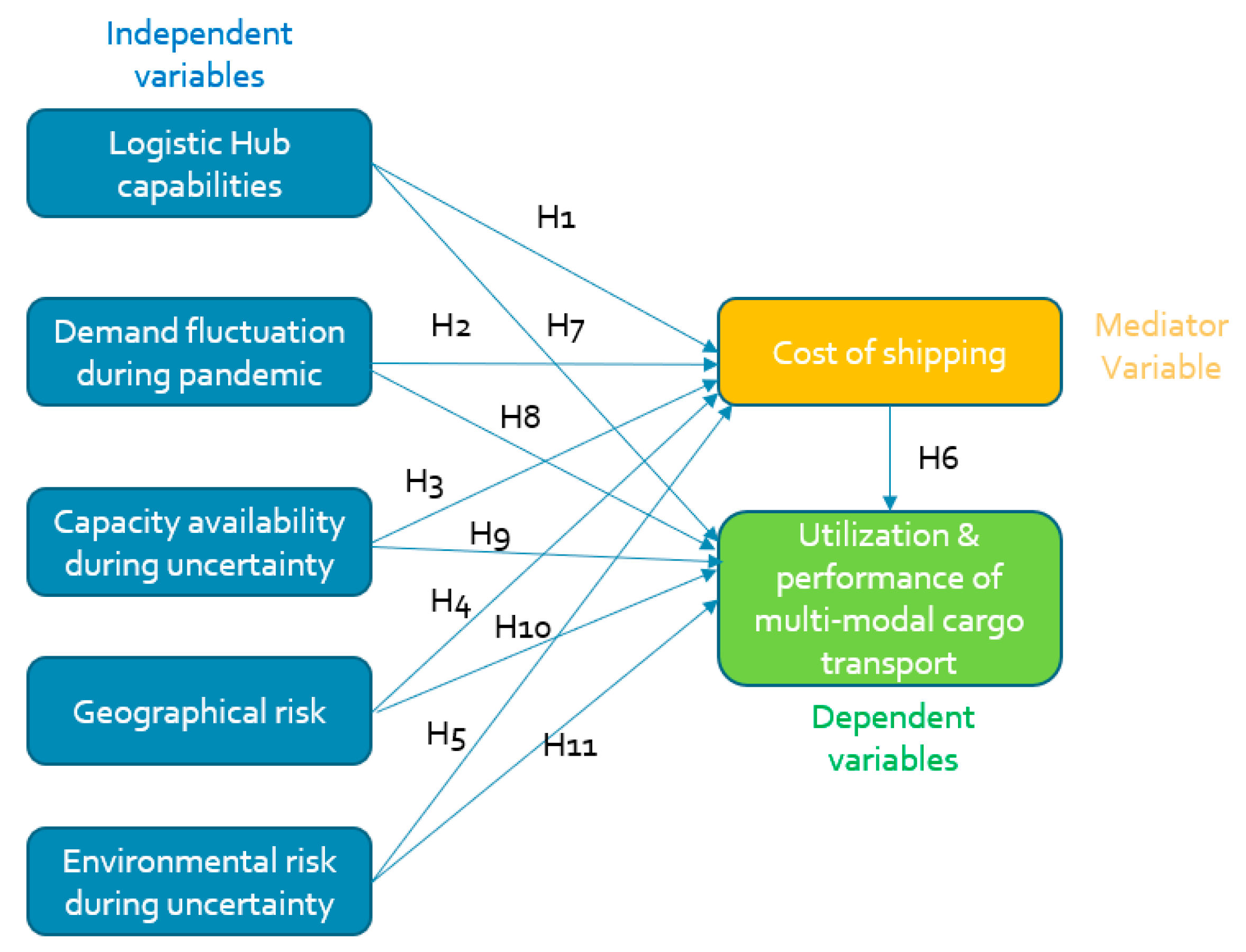
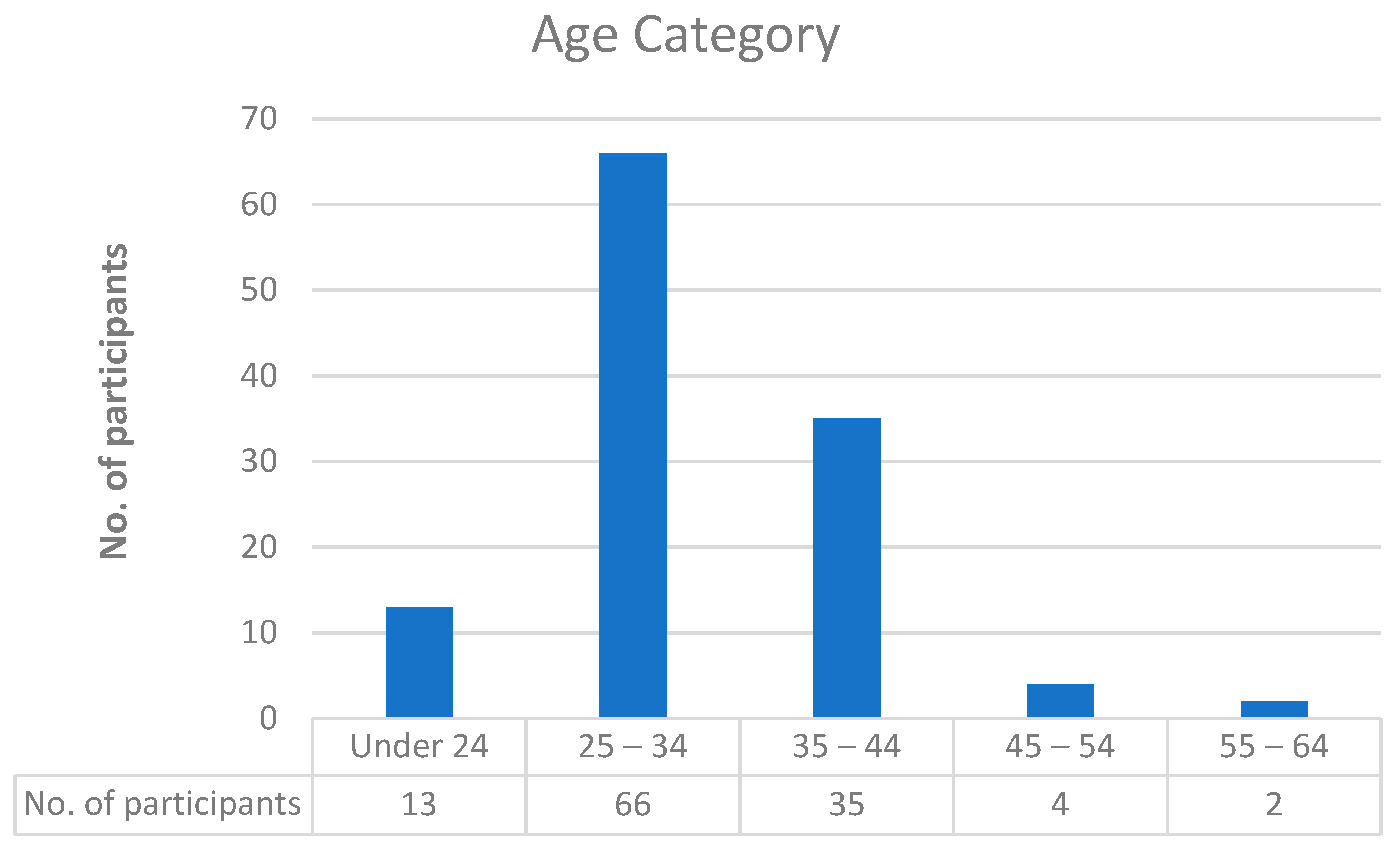
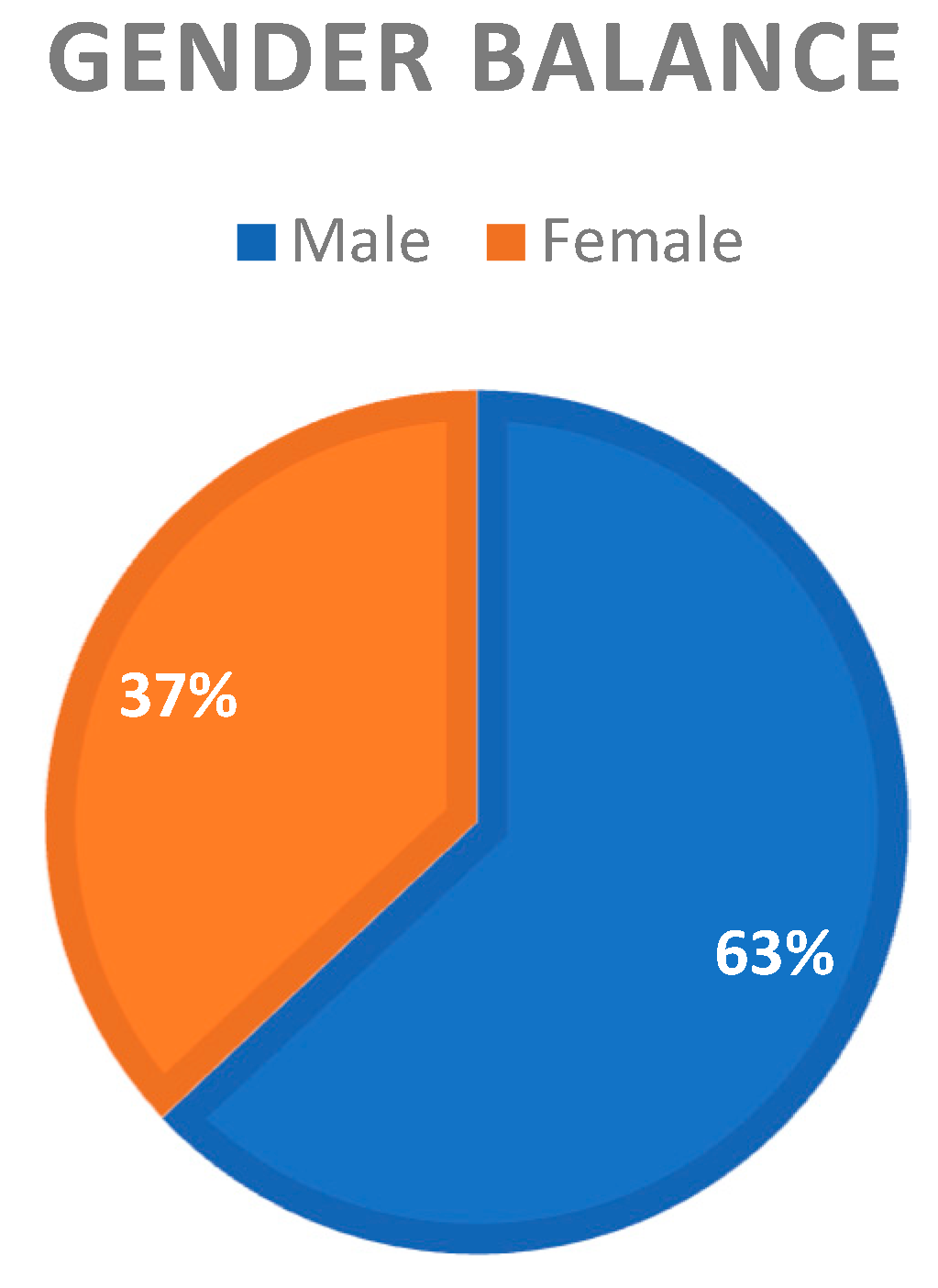
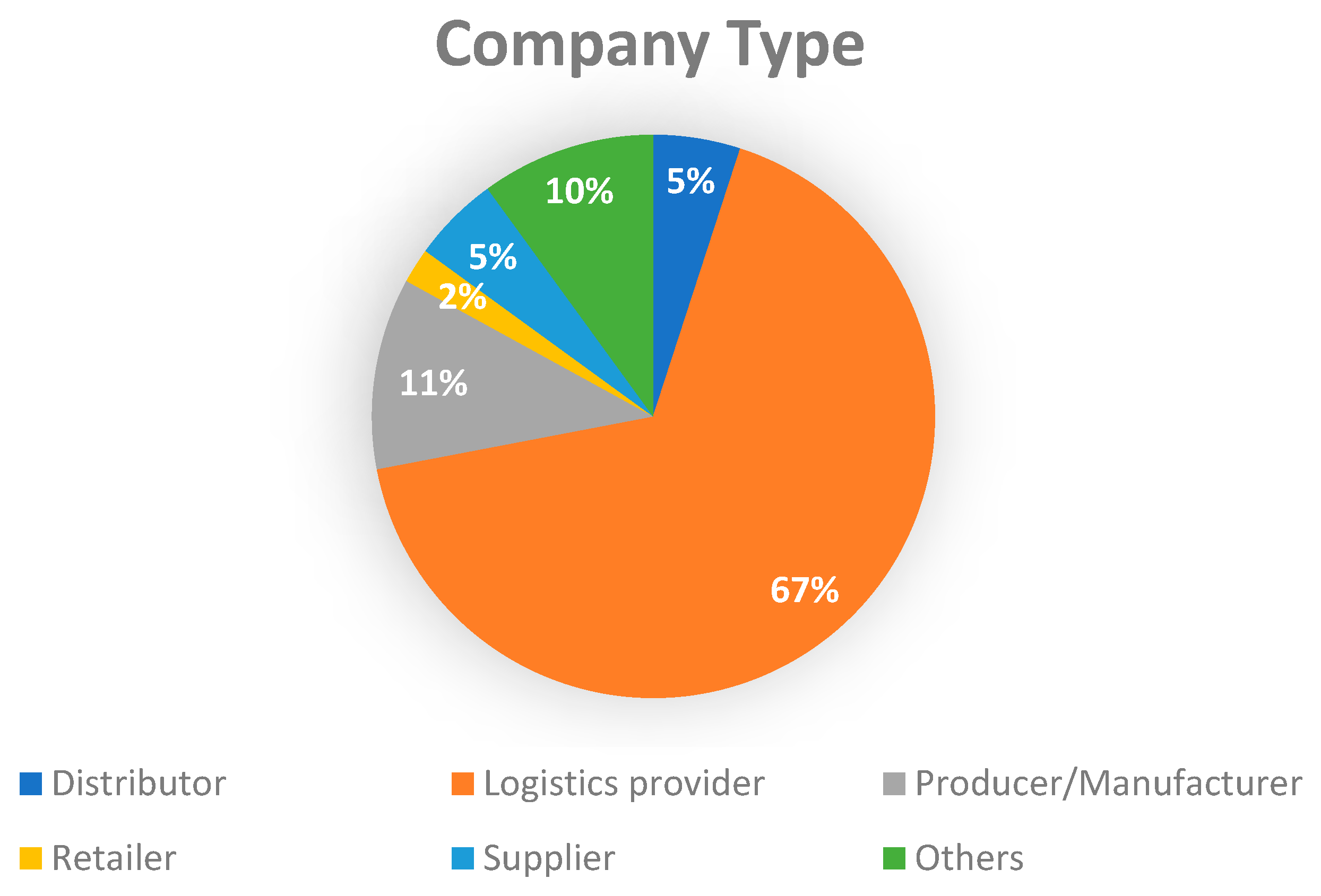
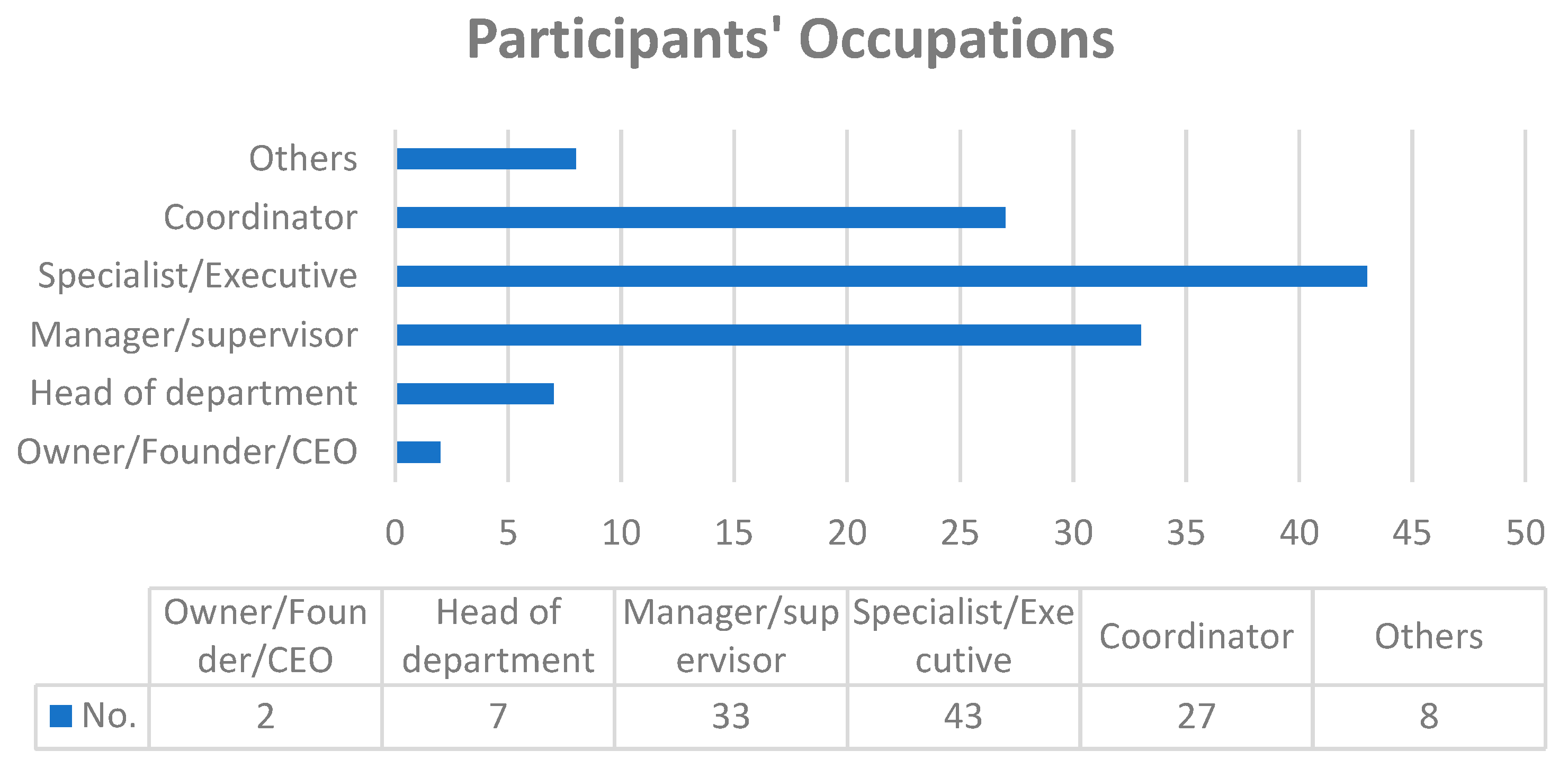
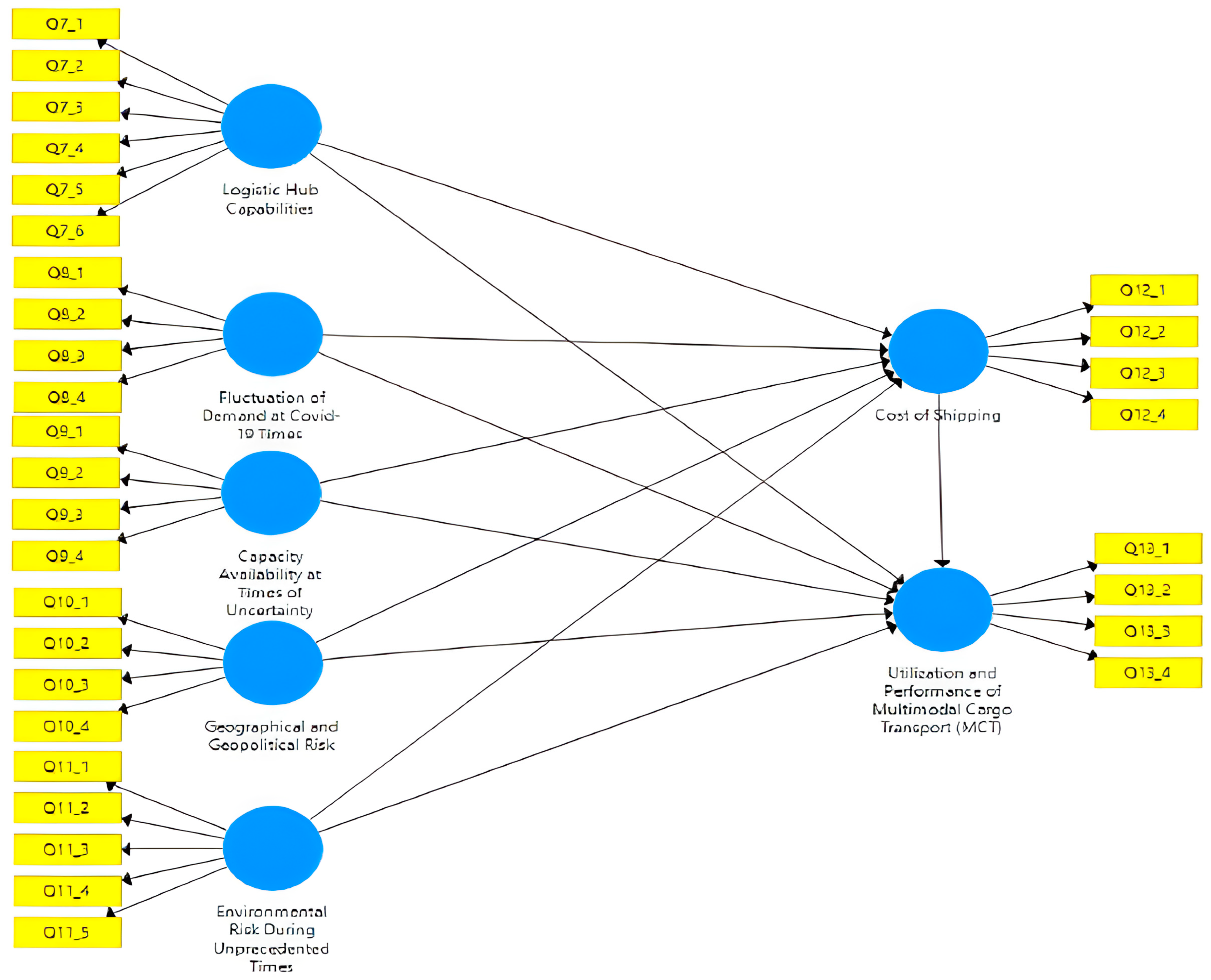
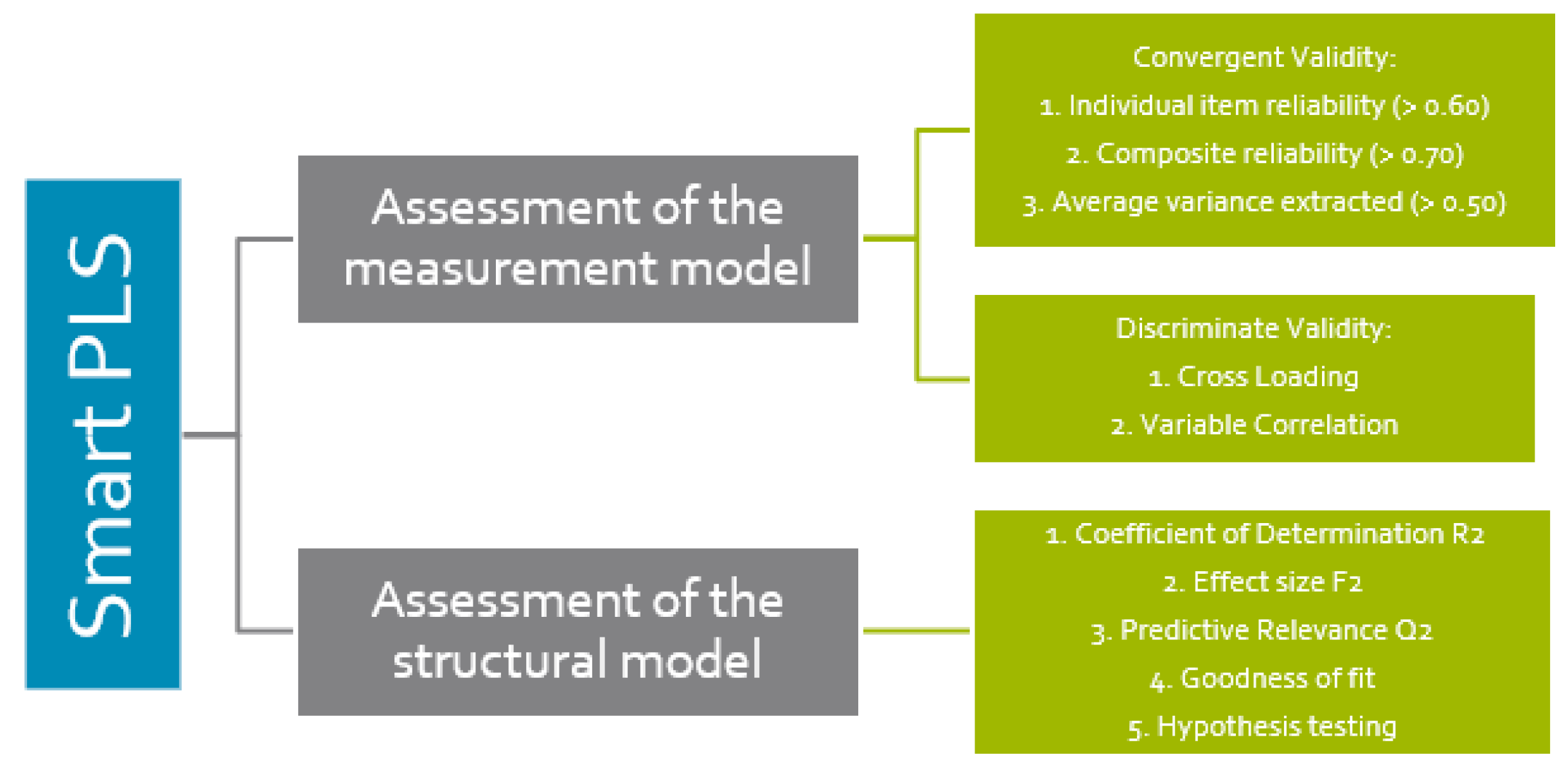
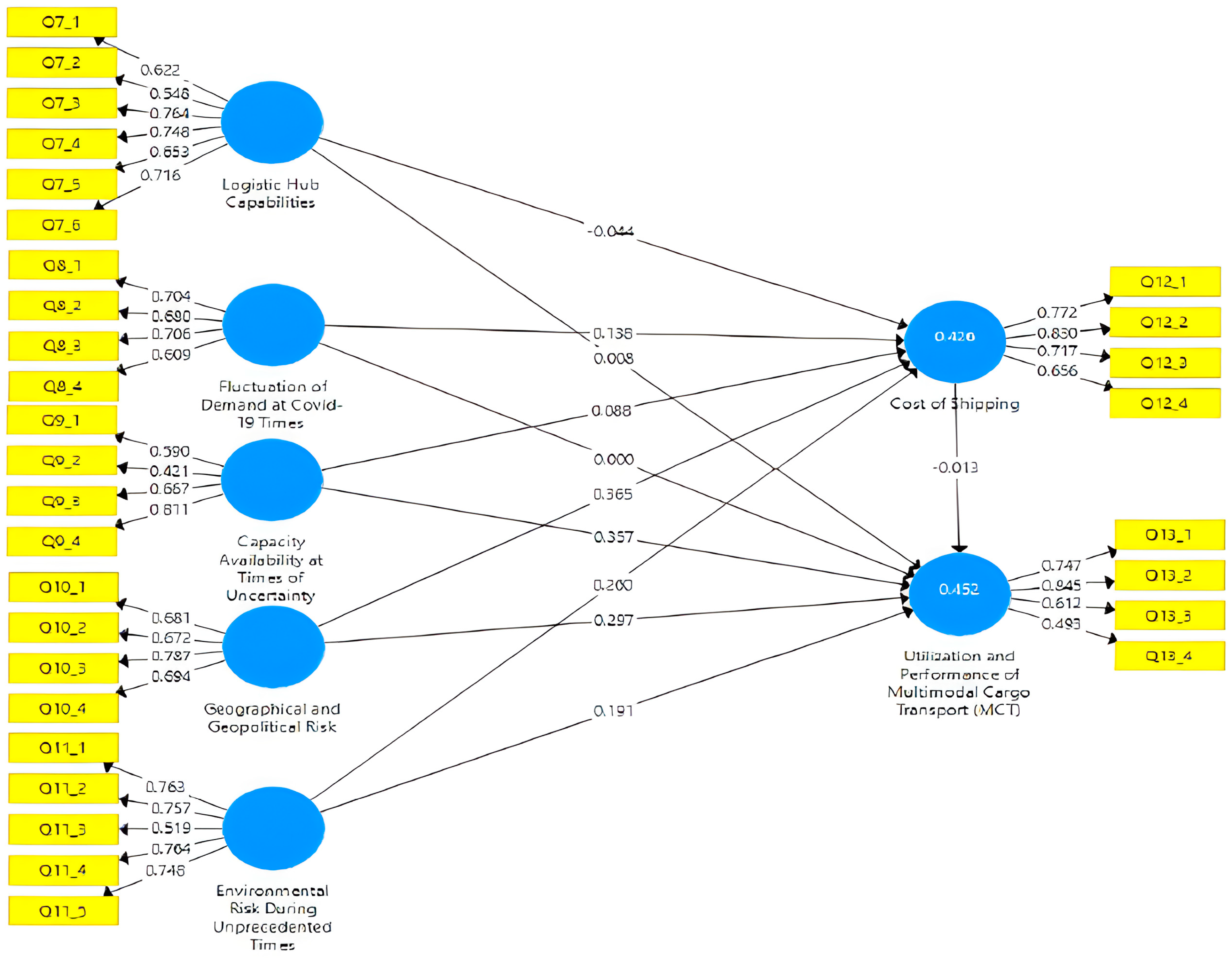
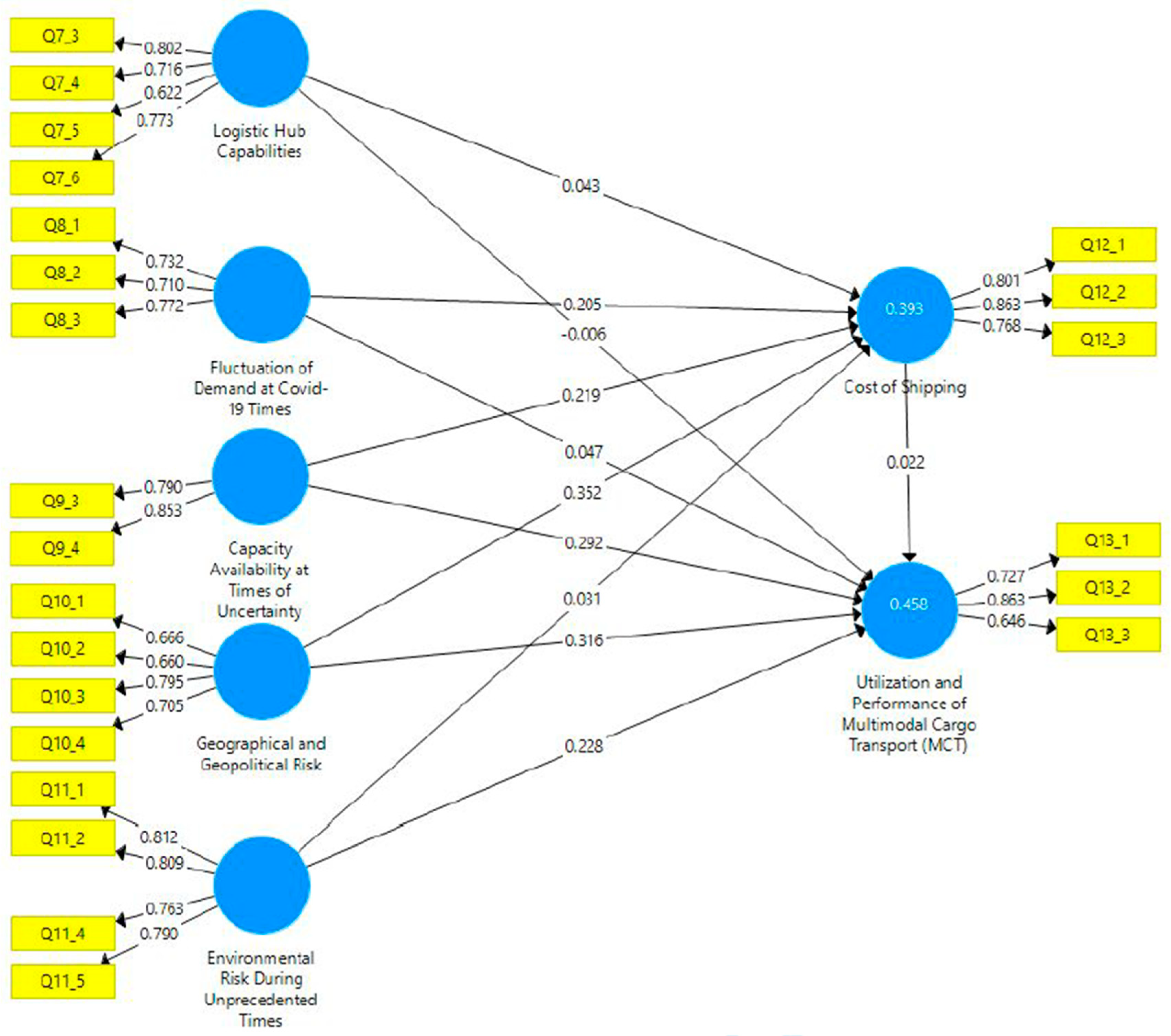
| Construct | Item Measurement |
|---|---|
| Logistic Hub Capabilities |
|
| The fluctuation of Demand at COVID-19 times |
|
| Capacity Availability at times of uncertainty |
|
| Geographical and Geopolitical Risk |
|
| Environmental Risk During Unprecedented Times |
|
| Cost of Shipping |
|
| Utilization and Performance of MCT |
|
| Variable | Construct | Factor Loading | Cronbach’s Alpha | rho_A | Composite Reliability | Average Variance Extracted (AVE) |
|---|---|---|---|---|---|---|
| Logistic Hub Capabilities | Q7_3 | 0.802 | 0.740 | 0.737 | 0.820 | 0.535 |
| Q7_4 | 0.716 | |||||
| Q7_5 | 0.622 | |||||
| Q7_6 | 0.773 | |||||
| Fluctuation of Demand at COVID-19 Times | Q8_1 | 0.732 | 0.588 | 0.594 | 0.783 | 0.546 |
| Q8_2 | 0.71 | |||||
| Q8_3 | 0.772 | |||||
| Capacity Availability at Times of Uncertainty | Q9_3 | 0.790 | 0.522 | 0.531 | 0.806 | 0.676 |
| Q9_4 | 0.853 | |||||
| Geographical and Geopolitical Risk | Q10_1 | 0.666 | 0.678 | 0.687 | 0.800 | 0.502 |
| Q10_2 | 0.66 | |||||
| Q10_3 | 0.795 | |||||
| Q10_4 | 0.705 | |||||
| Environmental Risk During Unprecedented Times | Q11_1 | 0.812 | 0.805 | 0.810 | 0.872 | 0.630 |
| Q11_2 | 0.809 | |||||
| Q11_4 | 0.763 | |||||
| Q11_5 | 0.790 | |||||
| Cost of Shipping | Q12_1 | 0.801 | 0.742 | 0.762 | 0.852 | 0.659 |
| Q12_2 | 0.863 | |||||
| Q12_3 | 0.768 | |||||
| Utilization and Performance of MCT | Q13_1 | 0.727 | 0.611 | 0.651 | 0.793 | 0.564 |
| Q13_2 | 0.863 | |||||
| Q13_3 | 0.646 |
| Cnow onst. | Logistic Hub Capabilities | Fluctuation of Demand at COVID-19 Times | Capacity Availability at Times of Uncertainty | Geographical/ Geopolitical Risk | Environmental Risk During Unprecedented Times | Cost of Shipping During Pandemic | Utilization/ Performance of MCT |
|---|---|---|---|---|---|---|---|
| Q7_3 | 0.802 | 0.231 | 0.190 | 0.240 | 0.422 | 0.203 | 0.251 |
| Q7_4 | 0.716 | 0.114 | 0.095 | 0.216 | 0.432 | 0.134 | 0.157 |
| Q7_5 | 0.622 | 0.133 | 0.129 | 0.074 | 0.322 | 0.013 | 0.064 |
| Q7_6 | 0.773 | 0.048 | 0.240 | 0.223 | 0.261 | 0.237 | 0.231 |
| Q8_1 | 0.129 | 0.732 | 0.270 | 0.247 | 0.303 | 0.280 | 0.308 |
| Q8_2 | 0.083 | 0.710 | 0.234 | 0.250 | 0.100 | 0.259 | 0.226 |
| Q8_3 | 0.162 | 0.772 | 0.271 | 0.317 | 0.351 | 0.398 | 0.255 |
| Q9_3 | 0.247 | 0.236 | 0.790 | 0.169 | 0.325 | 0.386 | 0.353 |
| Q9_4 | 0.157 | 0.335 | 0.853 | 0.404 | 0.379 | 0.345 | 0.506 |
| Q10_1 | 0.089 | 0.191 | 0.167 | 0.666 | 0.218 | 0.241 | 0.293 |
| Q10_2 | 0.083 | 0.365 | 0.141 | 0.660 | 0.161 | 0.255 | 0.367 |
| Q10_3 | 0.294 | 0.331 | 0.255 | 0.795 | 0.293 | 0.468 | 0.351 |
| Q10_4 | 0.273 | 0.179 | 0.388 | 0.705 | 0.297 | 0.461 | 0.459 |
| Q11_1 | 0.385 | 0.315 | 0.263 | 0.298 | 0.812 | 0.238 | 0.332 |
| Q11_2 | 0.372 | 0.320 | 0.356 | 0.199 | 0.809 | 0.197 | 0.471 |
| Q11_4 | 0.351 | 0.259 | 0.298 | 0.387 | 0.763 | 0.377 | 0.267 |
| Q11_5 | 0.392 | 0.243 | 0.424 | 0.256 | 0.790 | 0.283 | 0.448 |
| Q12_1 | 0.155 | 0.245 | 0.372 | 0.328 | 0.290 | 0.801 | 0.317 |
| Q12_2 | 0.257 | 0.421 | 0.350 | 0.570 | 0.347 | 0.863 | 0.362 |
| Q12_3 | 0.173 | 0.362 | 0.360 | 0.354 | 0.186 | 0.768 | 0.330 |
| Q13_1 | 0.090 | 0.169 | 0.371 | 0.250 | 0.211 | 0.237 | 0.727 |
| Q13_2 | 0.172 | 0.320 | 0.530 | 0.544 | 0.329 | 0.429 | 0.863 |
| Q13_3 | 0.354 | 0.286 | 0.256 | 0.331 | 0.548 | 0.227 | 0.646 |
| Shortcut | Circuitous |
|---|---|
| A | Capacity Availability at Times of Uncertainty |
| B | Cost of Shipping During Pandemic |
| C | Environmental Risk During Unprecedented Times |
| D | The Fluctuation of Demand at COVID-19 Times |
| E | Geographical and Geopolitical Risk |
| F | Logistic Hub Capabilities |
| G | Utilization and Performance of Multimodal Cargo Transport (MCT) |
| A | B | C | D | E | F | G | |
|---|---|---|---|---|---|---|---|
| A | 0.822 | ||||||
| B | 0.441 | 0.812 | |||||
| C | 0.43 | 0.343 | 0.794 | ||||
| D | 0.351 | 0.431 | 0.356 | 0.739 | |||
| E | 0.36 | 0.53 | 0.354 | 0.37 | 0.709 | ||
| F | 0.241 | 0.247 | 0.473 | 0.174 | 0.287 | 0.731 | |
| G | 0.529 | 0.416 | 0.488 | 0.357 | 0.53 | 0.277 | 0.751 |
| Hyp. | The Relation between IV and DV | Std. Beta | T Statistics | p Values | Decision |
|---|---|---|---|---|---|
| H1 | Logistic Hub Capabilities → Cost of Shipping | 0.043 | 0.495 | 0.621 | Rejected |
| H2 | Fluctuation of Demand at COVID-19 Times → Cost of Shipping | 0.205 | 1.675 | 0.094 | Rejected |
| H3 | Capacity Availability at Times of Uncertainty → Cost of Shipping | 0.219 | 2.51 | 0.012 | Accepted |
| H4 | Geographical and Geopolitical Risk → Cost of Shipping | 0.352 | 3.237 | 0.001 | Accepted |
| H5 | Environmental Risk During Unprecedented Times → Cost of Shipping | 0.031 | 0.239 | 0.811 | Rejected |
| H6 | Cost of Shipping → Utilization and Performance of MCT | 0.022 | 0.209 | 0.835 | Rejected |
| H7 | Logistic Hub Capabilities → Utilization and Performance of MCT | −0.006 | 0.066 | 0.948 | Rejected |
| H8 | Fluctuation of Demand at COVID-19 Times → Utilization and Performance of MCT | 0.047 | 0.507 | 0.612 | Rejected |
| H9 | Capacity Availability at Times of Uncertainty → Utilization and Performance of MCT | 0.292 | 2.769 | 0.006 | Accepted |
| H10 | Geographical and Geopolitical Risk → Utilization and Performance of MCT | 0.316 | 2.911 | 0.004 | Accepted |
| H11 | Environmental Risk During Unprecedented Times → Utilization and Performance of MCT | 0.228 | 2.248 | 0.025 | Accepted |
| Dependent Variables | R2 | Result |
|---|---|---|
| Cost of Shipping | 0.393 | Moderate |
| Utilization and Performance of Multimodal Cargo Transport | 0.458 | Moderate |
| Latent Variables | Cost of Shipping | Utilization and Performance of MCT |
|---|---|---|
| Capacity Availability at Times of Uncertainty | 0.059 (low) | 0.110 (low) |
| Cost of Shipping | NA | 0.001 (no effect size) |
| Environmental Risk During COVID-19 Times | 0.001 (no effect size) | 0.060 (low) |
| Fluctuation of Demand at COVID-19 Times | 0.054 (low) | 0.003 (no effect size) |
| Geographical and Geopolitical Risk | 0.155 (medium) | 0.122 (low) |
| Logistic Hub Capabilities | 0.002 (no effect size) | 0.000 (no effect size) |
| Latent Variables | SSO | SSE | Q2 (=1 − SSE/SSO) |
|---|---|---|---|
| Capacity Availability at Times of Uncertainty | 240 | 240 | |
| Cost of Shipping | 360 | 277.14 | 0.230 |
| Environmental Risk During Unprecedented Times | 480 | 480 | |
| The Fluctuation of Demand at COVID-19 Times | 360 | 360 | |
| Geographical and Geopolitical Risk | 480 | 480 | |
| Logistic Hub Capabilities | 480 | 480 | |
| Utilization and Performance of MCT | 360 | 285.276 | 0.208 |
| Indirect Relationship | T Statistics (|O/STDEV|) | p Values |
|---|---|---|
| Capacity Availability at Times of Uncertainty → Cost of Shipping → Utilization and Performance of Multimodal Cargo Transport (MCT) | 0.193 | 0.847 |
| Geographical and Geopolitical Risk → Cost of Shipping → Utilization and Performance of Multimodal Cargo Transport (MCT) | 0.188 | 0.851 |
| Environmental Risk During Unprecedented Times → Cost of Shipping → Utilization and Performance of Multimodal Cargo Transport (MCT) | 0.052 | 0.959 |
| Fluctuation of Demand at COVID-19 Times → Cost of Shipping → Utilization and Performance of Multimodal Cargo Transport (MCT) | 0.183 | 0.855 |
| Logistic Hub Capabilities → Cost of Shipping → Utilization and Performance of Multimodal Cargo Transport (MCT) | 0.081 | 0.936 |
Disclaimer/Publisher’s Note: The statements, opinions and data contained in all publications are solely those of the individual author(s) and contributor(s) and not of MDPI and/or the editor(s). MDPI and/or the editor(s) disclaim responsibility for any injury to people or property resulting from any ideas, methods, instructions or products referred to in the content. |
© 2023 by the authors. Licensee MDPI, Basel, Switzerland. This article is an open access article distributed under the terms and conditions of the Creative Commons Attribution (CC BY) license (https://creativecommons.org/licenses/by/4.0/).
Share and Cite
Aljadiri, R.; Sundarakani, B.; El Barachi, M. Evaluating the Impact of COVID-19 on Multimodal Cargo Transport Performance: A Mixed-Method Study in the UAE Context. Sustainability 2023, 15, 15703. https://doi.org/10.3390/su152215703
Aljadiri R, Sundarakani B, El Barachi M. Evaluating the Impact of COVID-19 on Multimodal Cargo Transport Performance: A Mixed-Method Study in the UAE Context. Sustainability. 2023; 15(22):15703. https://doi.org/10.3390/su152215703
Chicago/Turabian StyleAljadiri, Rami, Balan Sundarakani, and May El Barachi. 2023. "Evaluating the Impact of COVID-19 on Multimodal Cargo Transport Performance: A Mixed-Method Study in the UAE Context" Sustainability 15, no. 22: 15703. https://doi.org/10.3390/su152215703
APA StyleAljadiri, R., Sundarakani, B., & El Barachi, M. (2023). Evaluating the Impact of COVID-19 on Multimodal Cargo Transport Performance: A Mixed-Method Study in the UAE Context. Sustainability, 15(22), 15703. https://doi.org/10.3390/su152215703






